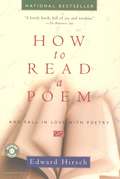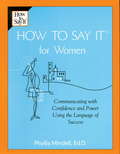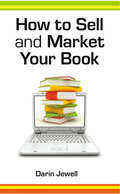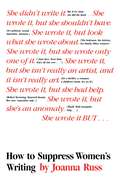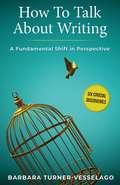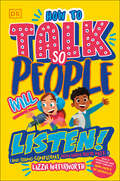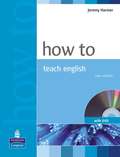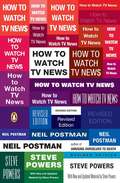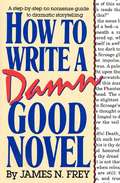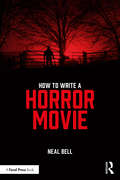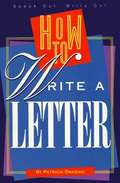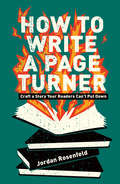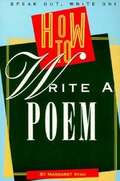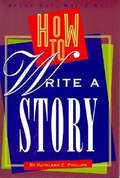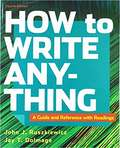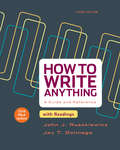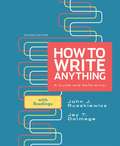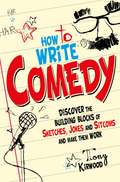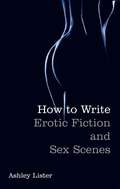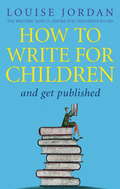- Table View
- List View
How To Read A Poem: And Fall in Love with Poetry
by Edward HirschFrom the National Book Critics Circle Award–winning poet and critic: “A lovely book, full of joy and wisdom.” —The Baltimore SunHow to Read a Poem is an unprecedented exploration of poetry, feeling, and human nature. In language at once acute and emotional, Edward Hirsch describes why poetry matters and how we can open up our imaginations so that its message can make a difference. In a marvelous reading of verse from around the world, including work by Pablo Neruda, Elizabeth Bishop, Wallace Stevens, and Sylvia Plath, among many others, Hirsch discovers the true meaning of their words and ideas and brings their sublime message home into our hearts.“Hirsch has gathered an eclectic group of poems from many times and places, with selections as varied as postwar Polish poetry, works by Keats and Christopher Smart, and lyrics from African American work songs . . . Hirsch suggests helpful strategies for understanding and appreciating each poem. The book is scholarly but very readable and incorporates interesting anecdotes from the lives of the poets.” —Library Journal“The answer Hirsch gives to the question of how to read a poem is: Ecstatically.” —Boston Book Review“Hirsch’s magnificent text is supported by an extensive glossary and superb international reading list.” —Booklist“If you are pretty sure you don’t like poetry, this is the book that’s bound to change your mind.” —Charles Simic, Pulitzer Prize–winning author of The World Doesn’t End
How To Say It for Women
by Phyllis MindellAn acclaimed expert on professional communications show women how to transform themselves by transforming their language; shed weak words, phrases, and gestures; empower themselves to win attention and respect; and get their ideas across with confidence and power.
How To Sell And Market Your Book: A Step-by-step Guide
by Darin JewellCovers new media opportunities and targeted at both self-published and traditionally-published authors. All authors want to sell as many copies of their books as possible. They also want to raise their literary profile as high as possible. There are more new routes to publication and also for sales and marketing than ever before. But where does the author start in such a competitive market? This book sets out clearly the promotional tools available and advises which paths are likely to sell the highest number of copies and which will help to establish the writer's name as a published author. It takes careful planning and know-how, but there is nobody better to promote a book than its author. The opportunities are out there and this guide will provide the information required for an author to maximise their chance of success.
How To Suppress Women's Writing
by Joanna RussA provocative survey of the forces that work against women who dare to write, by the renowed author of The Female Man and other classic science fiction.
How To Talk About Writing: A Fundamental Shift in Perspective
by Barbara Turner-VesselagoWith insight and clarity, Barbara Turner-Vesselago distils the essentials of ‘How To Talk About Writing’ into six revolutionary discoveries. This book provides invaluable advice for all who long to respond constructively to writers who seek their input, but who don’t know how or where to begin.Seasoned writing mentors and editors will be inspired to abandon old paradigms of editorial criticism. Those new to giving feedback will find straightforward tips—easy to comprehend and instantly rewarding to apply.Barbara Turner-Vesselago is the author of two successful writing books and a mentor to hundreds of published authors worldwide. Informative and user-friendly, this is a vital guide for writers’ groups, university seminars, and even for frank and informal one-on-one discussions between friends.
How To Talk So People Will Listen: And Sound Confident (Even When You’re Not)
by Lizzie WaterworthFind your voice and own the room, even when your legs are shaking!Professional cartoon voice artist Lizzie Waterworth tells you all about her strategies for confident speaking, from breathing exercises to what to do with your hands, and how to conquer that pesky inner voice that whispers "what if...?".Packed with funny stories from Lizzie's world of cartoons, and top tips from a host of professional voice artists and public figures, such as Stephen Fry, David Menkin, and BBC presenter Ben Shires, this book is full of practical advice to help you find your voice!'We teach our children reading and writing but we forget listening and speaking, which are essential life skills. Lizzie brilliantly fills that gap for speaking in this fun, easy to read manual for children of all ages (and parents too!). Every child should have this!' - Julian Treasure, top-10 TED speaker and author of How To Be Heard'The book looks really brilliant - I will definitely be using it for homework sessions with my younger ones.' - Dr Natalie Cawley, counselling psychologist and psychotherapist'Lizzie has a terrific way of helping folks overcome natural fears about speaking in front of others, and this book very much captures her spirit and energy. In How to Talk so People Will Listen, she draws on her professional knowledge and experience to treat the topic seriously while also making it fun.' - James Tierney, Yale University English Language Programs'This book is perfect for helping young ones learn essential skills and grow self-confidence all whilst having fun reading!' - Claudia Dalley, Head of POP Channels'This book is great because it's instructional without being full of jargon...and it's funny too! Definitely one for children and adults even!' - Monique Berry, Headteacher'It&’s like a cartoon on the outside and inside the playfulness continues. I really think this book is an invaluable resource. Although this book is designed for young people, Lizzie&’s advice is applicable to people of any age.' - Ranny Levy, Founder and President, KIDS FIRST! / Coalition for Quality Children's Media
How To Teach English
by Jeremy HarmerHow to Teach English is an easy-to-read, practical introduction to English Language Teaching. It is an essential reference work for trainee teachers preparing for exams such as CELTA or Certificate in TESOL.
How To Watch TV News
by Neil Postman Steve PowersA scathing and prescient look at television news,now updated for the new tech-savvy generation Television news : genuine information or entertainment fodder? Fifteen years ago, Neil Postman, a pioneer in media education and author of the bestselling Amusing Ourselves to Death, and Steve Powers, an award-winning broadcast journalist, concluded that anyone who relies exclusively on their television for accurate world news is making a big mistake. A cash cow laden with money from advertisers, so-called news shows glut viewers with celebrity coverage at the cost of things they really should know. Today, this message is still appallingly true but the problems have multiplied? along with the power of the Internet and the abundance of cable channels. A must-read for anyone concerned with the way media is manipulating our worldview, this newly revised edition addresses the evolving technology and devolving quality of America?s television news programming.
How To Write A Damn Good Novel: A Step-By-Step No Nonsense Guide To Dramatic Storytelling
by James N. FreyWritten in a clear, crisp, accessible style, this book is perfect for beginners as well as professional writers who need a crash course in the down-to-earth basics of storytelling. Talent and inspiration can't be taught, but Frey does provide scores of helpful suggestions and sensible rules and principles. An international bestseller, How to Write a Damn Good Novel will enable all writers to face that intimidating first page, keep them on track when they falter, and help them recognize, analyze, and correct the problems in their own work.
How To Write A Horror Movie
by Neal BellHow to Write a Horror Movie is a close look at an always-popular (but often disrespected) genre. It focuses on the screenplay and acts as a guide to bringing scary ideas to cinematic life using examples from great (and some not-so-great) horror movies.Author Neal Bell examines how the basic tools of the scriptwriter’s trade - including structure, dialogue, humor, mood, characters, and pace – can work together to embody personal fears that will resonate strongly on screen. Screenplay examples include classic works such as 1943’s I Walked With A Zombie and recent terrifying films that have given the genre renewed attention like writer/director Jordan Peele’s critically acclaimed and financially successful Get Out. Since fear is universal, the book considers films from around the world including the ‘found-footage’ [REC] from Spain (2007), the Swedish vampire movie, Let The Right One In (2008) and the Persian-language film Under The Shadow (2016). The book provides insights into the economics of horror-movie making, and the possible future of this versatile genre. It is the ideal text for screenwriting students exploring genre and horror, and aspiring scriptwriters who have an interest in horror screenplays.
How To Write A Letter
by Patricia DragisicDescribes the basic parts of many types of business and personal letters, offers examples of each kind, and suggests ways towrite effectively for particular situations.
How To Write A Page-Turner: Craft a Story Your Readers Can't Put Down
by Jordan RosenfeldInfuse Your Fiction with the Powerful Tug of Tension! Tension is the heart of conflict, the backbone of uncertainty, the hallmark of danger. It keeps readers guessing and characters on their toes. When you've got tension in place, stories leave readers breathless and wanting more. When it's missing, scenes feel inconsequential, plots drag, and characters meander. Learning the craft of writing can sometimes feel like a paint by numbers approach--connect compelling character A to plot event B. To avoid writing that's formulaic, predictable, and slow, How to Write a Page Turner will help you sew the threads of tension tight for an unforgettable story. You'll learn how to:Recognize the essential tension elements of danger, conflict, uncertainty, and withholding, and add them to your fictionCreate levels of tension in your characters through flaws, dialogue, power struggles, and moreBuild tension at energetic markers throughout the plotUse intimate imagery, strong sentences, and well-chosen words to build tension in expositionWhile this book walks you through the key areas that need tension building, from character to plot, it also delves deeper, analyzing exceptional examples from contemporary fiction's most gripping page-turners. So as you dive into the inner conflicts of a character's deepest psyche, to the mechanics of how you reveal information to the reader, you'll also discover how to craft a story your readers can't put down!
How To Write A Poem
by Margaret RyanWriting poetry is one of the most difficult and demanding skills in all arts. How to Write a Poem illustrates to readers the techniques for manipulating rhythm and aural texture. With clear and lucid language, author Margaret Ryan introduces the reader to terminology essential to develop the poet's ear, including rhyme schemes, masculine and feminine endings, internal rhyme, and vowel intonation. With its broad approach and lucid text, How to Write a Poem is ideal for both the serious poet and the student.
How To Write A Story
by Kathleen C. PhillipsExamines the basics of writing a story, from finding a title and beginning the work to completing and revising it.
How To Write Anything With Readings: A Guide And Reference
by John J. Ruszkiewicz Jay T. DolmageInstructors at hundreds of colleges and universities have turned to How to Write Anything for support that empowers every student with advice they need, when they need it. And students love it--holding onto the book for other classes --because the authors' tone makes writing in any genre approachable, with a flexible, rhetorical framework for the most commonly taught academic and public genres. <P><P> The fourth edition offers students a new Part 1: Strategies for College Writing, even more support for understanding genres and purpose, and an expanded and thoroughly revised take on grammar, mechanics, and usage--all essential to academic success. The result is everything you need to teach composition in a flexible and highly visual guide, reference, handbook, and reader. <P><P> Also available: LaunchPad, an online course space with pre-built units featuring the full e-book, book-specific reading comprehension quizzes, adaptive LearningCurve activities to help students hone their understanding of reading and writing, and additional support in A Student's Companion to How to Write Anything.
How To Write Anything with Readings with 2016 MLA Update
by John J. Ruszkiewicz Jay T. DolmageTHIS TITLE HAS BEEN UPDATED TO REFLECT THE 2016 MLA UPDATES! Our editorial team has updated this text based on content from The MLA Handbook, 8th Edition. Browse our catalog or contact your representative for a full listing of updated titles and packages, or to request a custom ISBN. Instructors at hundreds of colleges and universities have turned to How to Write Anything for clear, focused writing advice that gives students just what they need, when they need it. And students love it—because John Ruszkiewicz’s tone makes writing in any genre approachable, with a flexible, rhetorical framework for a range of common academic and real-world genres, and a reference with extra support for writing, research, design, style, and grammar. The new edition also gives students more support for writing portfolios, more help working with the concept of genre, and more emphasis on critical reading and writing—all essential to academic success. And you’ll find more teaching ideas and syllabi from the community of teachers led by coauthor Jay Dolmage. The result is everything you need to teach composition in a flexible and highly visual guide, reference, and reader.
How To Write Anything: A Guide and Reference with Readings
by John J. Ruszkiewicz Jay T. DolmageHow to Write Anything supports students wherever they are in their writing process. Designed to be clear and simple, the Guide lays out focused advice for writing common academic and real-world genres, while the Reference covers the range of writing skills that students needs as they work across genres and disciplines. Genre-based readings -- including narratives, reports, arguments, evaluations, proposals and rhetorical, causal, and literary analyses -- are sure to engage students and inspire ideas. The result is everything you need to teach composition in a flexible, highly visual guide, reference and reader. This new edition gives students more support for academic writing, more help choosing and working with genres, and more emphasis on multimodal composing.
How To Write Comedy: Discover The Building Blocks Of Sketches, Jokes And Sitcoms - And Make Them Work
by Tony KirwoodFirst you have to come out with a flow of ideas and decide which ones will work. Then you must give them a tight structure, and then write crisp dialogue which builds in constant laughs. This practical but inspirational book guides new and more experienced writers step by step through the process of each comedy genre. It gives space for your creativity to shine as you gradually build your skills.Beginning with sketches, the basic building blocks of comedy, you?ll find how you can quickly create great premises, and then structure them into two-minute slices of hilarity. The same techniques will help you write a string of jokes and one-liners.· A practical guide to comedy as you write it, from creating mindmaps from which to glean your new material, to techniques of structure, characterisation and dialogue which work.· Covers the distinct techniques and mindsets needed by each genre in turn, in the usual progression of a writer?s career - from jokes and sketches to sitcoms.You?ll also learn how to find outlets for your work, from submitting to the BBC to staging your own show or filming comedy for the internet.
How To Write Comedy: Discover the building blocks of sketches, jokes and sitcoms – and make them work
by Tony KirwoodFirst you have to come out with a flow of ideas and decide which ones will work. Then you must give them a tight structure, and then write crisp dialogue which builds in constant laughs. This practical but inspirational book guides new and more experienced writers step by step through the process of each comedy genre. It gives space for your creativity to shine as you gradually build your skills.Beginning with sketches, the basic building blocks of comedy, you’ll find how you can quickly create great premises, and then structure them into two-minute slices of hilarity. The same techniques will help you write a string of jokes and one-liners.· A practical guide to comedy as you write it, from creating mindmaps from which to glean your new material, to techniques of structure, characterisation and dialogue which work.· Covers the distinct techniques and mindsets needed by each genre in turn, in the usual progression of a writer’s career - from jokes and sketches to sitcoms.You’ll also learn how to find outlets for your work, from submitting to the BBC to staging your own show or filming comedy for the internet.
How To Write Crime Fiction
by Sarah WilliamsThis book provides a comprehensive overview of all the different kinds of crime fiction, with examples from successful contemporary writers in each of the different genres, and clear explanations and exercises to help the beginning writer hone their craft, and discover the kind of crime fiction, the plots, the themes, the language, that work best for them.
How To Write Crime Fiction
by Sarah WilliamsThis book provides a comprehensive overview of all the different kinds of crime fiction, with examples from successful contemporary writers in each of the different genres, and clear explanations and exercises to help the beginning writer hone their craft, and discover the kind of crime fiction, the plots, the themes, the language, that work best for them.
How To Write Erotic Fiction and Sex Scenes
by Ashley ListerWhether you're writing a steamy erotic novel, or a romantic novel and want to take the reader beyond the bedroom door, writing a convincing sex scene can be one of the most difficult challenges for any fiction writer. How to Write Erotic Fiction and Sex Scenes is a practical guide to help every writer rise to this challenge.
How To Write Erotic Fiction and Sex Scenes
by Ashley ListerWhether you're writing a steamy erotic novel, or a romantic novel and want to take the reader beyond the bedroom door, writing a convincing sex scene can be one of the most difficult challenges for any fiction writer. How to Write Erotic Fiction and Sex Scenes is a practical guide to help every writer rise to this challenge.
How To Write For Children And Get Published
by Louise JordanHuge numbers of people want to write for children, but it is notoriously difficult to find a publisher in this increasingly comeptitive area. This inspiring and practical guide from acknowledged expert on children's publishing Louise Jordan, will show you how to make your work stand out from the crowd and appeal to commissioning editors, and, of course, your intended audience.
How To Write For Children And Get Published
by Louise JordanHuge numbers of people want to write for children, but it is notoriously difficult to find a publisher in this increasingly comeptitive area. This inspiring and practical guide from acknowledged expert on children's publishing Louise Jordan, will show you how to make your work stand out from the crowd and appeal to commissioning editors, and, of course, your intended audience.
